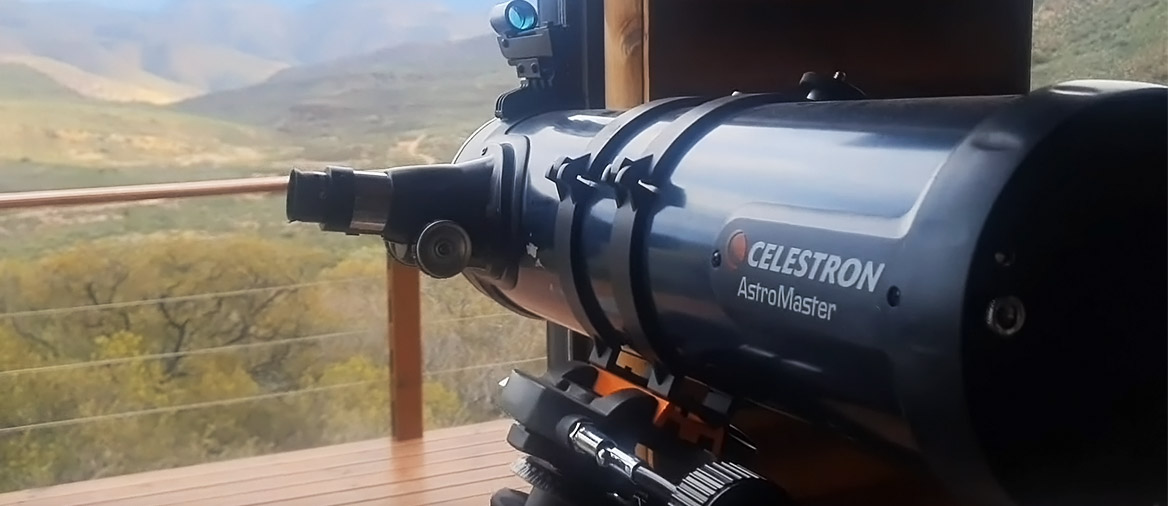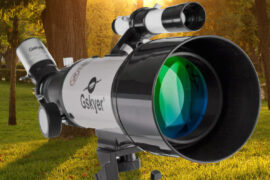The AstroMaster line of telescopes is very popular among beginner stargazers due to their good quality and reasonable pricing.
But many people want more power than the entry-level 70mm or 90mm refractors can offer as well as something that is going to last for a long time. And that’s where the AstroMaster 114EQ comes in.
This telescope is the smallest Newtonian telescope that Celestron makes. It is still considered to be an entry-level device, but dues to its design, it can offer a lot more power than the previously mentioned devices.
But is it worth the money? or are you better off looking at other options?
In this article, I’ll review the Celestron AstroMaster 114EQ. I’ve had the chance to test on multiple occasions and compare it side to side with other comparable models. I’ll try to answer all your questions about so you can make an informed decision.
If you are in a hurry and just want the quick rundown, here it is in the next section. However, I’d recommend you to at least skim the rest so you can get a better idea about why I reached those conclusions.
The Verdict
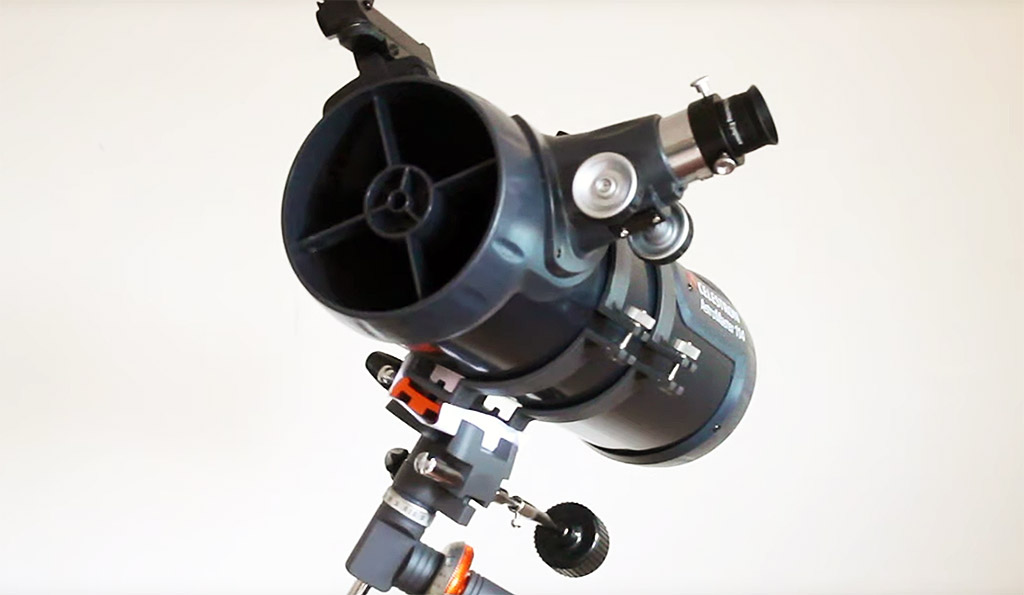
The AstroMaster 114EQ is a serviceable telescope. The optics are great, the build quality is ok (although the tripod is not Celestron’s best work), and it comes with all the accessories you need to get started.
If you decide to buy it, it will probably last you for a long time, and you’ll be quite happy with it.
That being said, I do have a bit of a problem with it, and that’s the price. Not because it is high, but because for just a few dollars more you can get its big brother, the AstroMaster 130EQ which offers the same quality, but a bit extra power.
But beyond that, if you are on a set budget and don’t want to spend more than absolutely necessary, or if you can find it on sale, the AstroMaster 114EQ is a solid purchase for a first-time telescope user or someone upgrading from a basic 60mm-90mm aperture telescope.
Note: For kids, I generally don’t recommend going with a Newtonian telescope because the mount is a bit harder to use and they require some maintenance. However, if they’ll have adult help to use it and take care of it then disregard this warning. But if that sounds like something you don’t want to deal with, check out these refracting telescope recommendations instead.
Ratings
| Optics | 9/10 |
| Build quality | 8/10 |
| Ease of use | 8/10 |
| Portability | 9/10 |
| Accessories | 7/10 |
| Price |
Technical specifications and their meaning
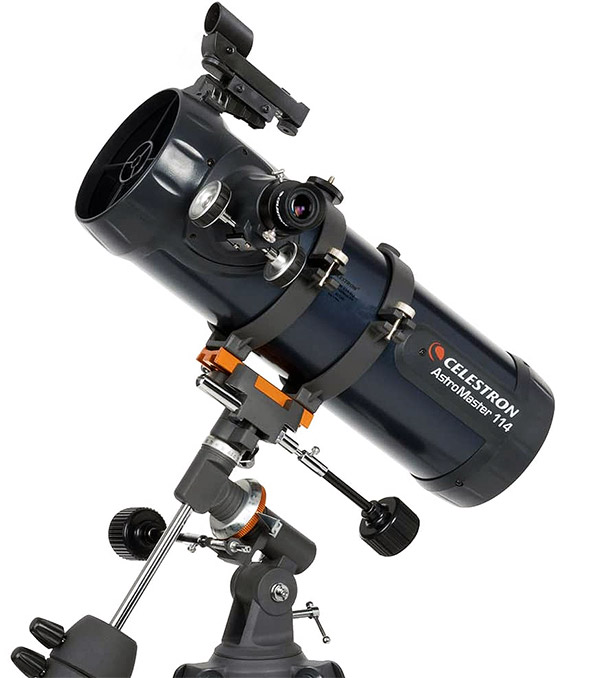
| Model name | AstroMaster 114 |
| Manufacturer | Celestron |
| Telescope type | Reflector/Newtonian |
| Aperture | 114 mm (4.5″) |
| Focal length | 1000 mm (39.3″) |
| Focal ratio | f/8.7 |
| Assembled Weight | 7.7 Kg (17 lb) |
| Eyepiece slot | 1.25″ |
| Maximum magnification | 269x |
| Limiting magnitude | 12.8 |
| Included eyepieces | Kellner 20mm, Kellner 10mm |
| Tripod | Aluminum |
| Mount | Equatorial |
| Other included accessories | red dot finderscope, star diagonal |
Aperture – The diameter of the primary mirror.
Focal length – The distance traveled by the light from the primary mirror to the exit point.
Focal ratio – Focal length / aperture. Also referred to as how “fast” the telescope is.
Maximum magnification – The magnification limit for the telescope. Beyond that, you won’t get any extra detail and you might even get blurriness. Magnification is determined by the focal length and the eyepiece being used at any given time. Here’s a calculator for it.
Limiting magnitude – Maximum “brightness” of the objects (stars, galaxies, etc) the telescope can see under good sky conditions. Lower magnitude = brighter objects.
Full review
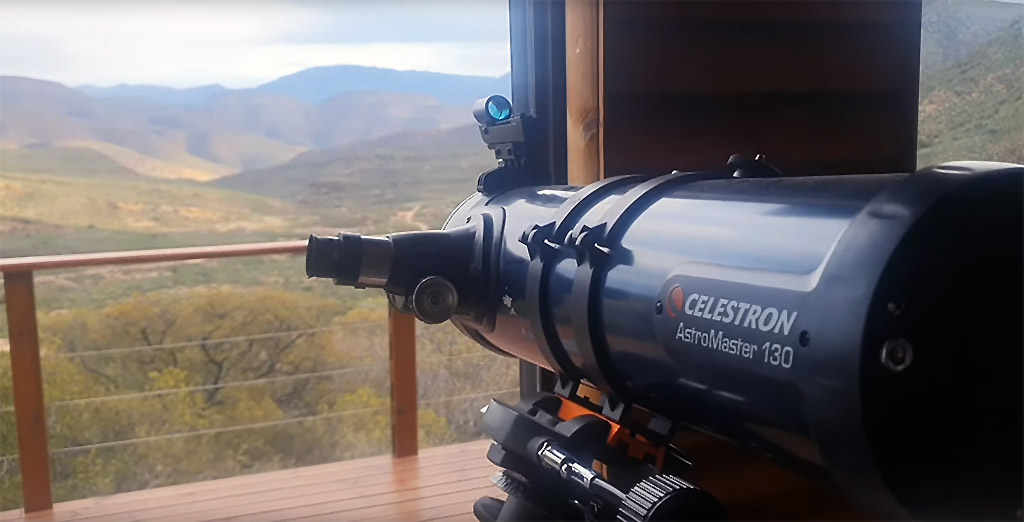
Power and magnification
The AstroMaster 114EQm as its name implies, boasts an aperture of 114mm (4.5″). My recommended minimum aperture for beginners is 70mm, so you are good to go there, it beats that comfortably.
An aperture of 114mm will allow you to do the following:
- The moon will look spectacular. You will be able to see every large crater in detail as well as all the major geological features. You won’t be able to see the flags on the Moon, but no telescope can.
- Mars, Venus, and Jupiter are great targets for this telescope. You will be able to get see them clearly and with some luck you might even see some of their features like Mars’ poles and Jupiter’s red dot. Some of their moons will be visible too.
- You will be able to see Saturn and its rings.
- Mercury, Uranus, and Neptune will be visible but will look just like colored dots. These targets are hard to get any detail from even for professional telescopes.
- You will be able to see all the major star clusters and dozens of the brightest galaxies and nebulae. This includes the Andromeda galaxy, the Eagle Nebula, the Pillars of Creation, the Triangulum Galaxy, and the Sombrero Galaxy amongst many others.
Optics
The images resolved by the AstroMaster 114EQ are bright and sharp. I did not detect any spherical aberrations or other types of manufacturing issues.
The colors and contrast were ok compared to other Newtonians of the same aperture range but I wouldn’t say they were the best.
I did notice some “comas” (halos, tails) when looking at groups of stars, but that is to be expected. Most Newtonian telescopes tend to produce this effect.
One of the features of this telescope is that already comes with a 2X “Barlow lens” built into the focuser. A Barlow lens is an accessory that can multiply the magnification of the eyepiece being used. This means that you won’t need to purchase one separately which is great. The small tradeoff of that is that Barlows of other sizes (3x, 1.5X, etc) might not work properly with your telescope, so avoid spending money on those.
Build quality
Even though it uses a lot of plastic parts, I have no complaints about the build quality of the tube.
That being said, the mount and tripod are the weakest parts of this telescope. The tripod does feel a bit wobbly at times and the tube can feel unstable at times if it is not on a perfectly flat surface. At first, I wasn’t sure if this was an issue with the unit I tested so I checked out other reviews and it seems to be a prevalent issue. The good news is that some users have looked into the issue and it looks to be easily fixable with some moly grease. Here’s the fix:
“Loose bolts here and there, with some of that awful super-thick grease some manufacturers use which ends up being practically glue instead of a grease, yuck. That stuff does not help when you need smooth operation. I cleaned all of that out and applied some proper moly grease here and there, adjusting bolts and brackets as I went. Lo and behold, an extremely sturdy and smooth-working tripod and equatorial mount. Brilliant.”
Setup
One thing nobody tells you about Newtonians when they are trying to sell you one is that the first time using it can be slightly frustrating. Newtonians need to be collimated every once in a while. That means, re-aligning the mirrors that move just slightly from day-to-day usage and moving the telescope around. Telescopes generally come collimated from the fabric. The problem is, they will sometimes move during shipping, and depending on your luck, yours might need to be collimated the first time you use it.
The worst part about this is that you need a laser collimator to do this, which is not included. A budget collimator like this one from SVBONY should do the trick. I’d recommend grabbing one even if your unit turns out to not need collimation the first time you use it. You will still need to collimate it every 6-12 months.
Collimating a Newtonian telescope is not hard. Once you get the hang of it, it will take you 5-10 minutes. But for a complete beginner, it can be challenging and frustrating because you just want to use your brand-new telescope.
Accessories
The accessories the AstroMaster 114EQ comes with out of the box are pretty standard.
It comes with two Kellner eyepieces, a 20mm and a 10mm. These are fine as starting eyepieces and should be enough to get you started.
As I mentioned above, the focuser already has a 2x Barlow lens built-in, that’s why one is not included. This also means that once you want to upgrade your eyepiece collection, I wouldn’t recommend getting a kit that includes a Barlow as you’d have no use for it. Instead, I’d recommend trying a zoom eyepiece, which is a type of eyepiece that has many magnifications (usually 7mm to 21mm) instead of a single one. We have an article covering the best zoom eyepieces if you want to check it out.
Conclusions
The AstroMaster 114EQ is a good entry-level Newtonian telescope. This is the kind of telescope that will last you for many years and grow with you from beginner to enthusiast.
That being said, you need to understand that it is not a plug-and-play device. It has a learning curve due to having to learn to collimate it and align the equatorial mount before you even get to use it. This will be frustrating to some users that might have different expectations from a device that is meant to be “entry-level”.
I would not recommend this to kids or people looking for a more “point-and-shoot” kind of experience. If that’s your case, try a refractor telescope instead (here are some recommendations).
But if you are willing to go through the learning process, you’ll have a great time with it as it offers a lot more power than a refractor.
As I mentioned in the first section, I’d also recommend taking a look at its big brother, the AstroMaster 130EQ. If the prices are not too far away from each other at the moment of your purchase, consider getting even more power with that one instead.

